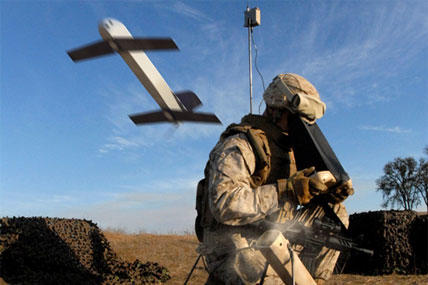As the war winds down in Afghanistan and the military shifts its footing toward new threats , the Pentagon's rapid fielding office is expanding to take on longer-term prototyping and developmental projects.
"We are going to look more at developmental prototyping in addition to what we've done over the last couple of years which is operational prototyping," Earl Wyatt, Deputy Assistant Secretary of Defense, Rapid Fielding, told Military.com in an interview.
This comes at the same time that budgets across the Defense Department are dropping and many have questioned the future of military agencies that were stood up to respond to the needs of the wars in Iraq and Afghanistan. However, Wyatt told Military.com he expects Rapid Fielding to survive the budget axe.
Over the last ten years during the wars in Iraq and Afghanistan, the Pentagon's rapid fielding effort has been working to deliver urgently needed technologies requested by commanders on a "quick-turn" or rapid timetable, Wyatt said.
"In large part, operational prototyping was targeted toward what we could get out to the field in a two-to-three year time frame. Developmental prototyping is a little bit riskier approach where you are not necessarily going with the most mature technology," he added.
Wyatt's rapid fielding office, which was formally stood up in 2009 but preceded by similar entities, recently approved a list of new Joint Capability Technology Demonstrations, or JCTDs. These are essentially developmental projects aimed at developing next-generation technology. The new list of JCTDs emphasizes computers, communications and electromagnetic spectrum or "jamming" capabilities.
The list of JCTDs provide a window into some of the Pentagon's developmental and technological priorities as it shifts to a new footing following more than 10 years of ground war in Iraq and Afghanistan.
"Maybe with some of our lessons learned over the last several years we might enable the introduction of new capabilities. The JCTDs will be a part of that," said Wyatt.
The Pentagon's budget for rapid fielding and JCTDs is going up in terms of requested amounts. Wyatt's office received $255 million in 2013 and has requested $328 million for fiscal year 2014, according to Pentagon officials. The increased request contains more funds for JCTDs as well.
Wyatt's rapid fielding office regularly works closely with services. For example, the office helped identify and deliver a tethered aerostat called Persistent Ground Surveillance System, or PGSS. PGSS was used to help protect Forward Operating Bases in Afghanistan.
"We facilitated the rapid insertion of these aerostats to be able to give the FOB team surveillance so they could see the adversary coming and be able to take indirect action maybe mortar action – or properly position resources to be able to brunt that attack," Wyatt said.
Wyatt's office was also involved in development and delivery of a robotically transported seismic sensor engineered to detect activity underground called the Rapid Reaction Tunnel Detection system, said Robin Hicks, director of JCTD programs.
"We've had dozens of ACTDs (Advanced Concept Technology Demonstration) and JCTDs that have made their way into operations," Hicks explained.
Now, in addition to its known operational mission, Wyatt's office will be exploring longer-term technological solutions and programs aimed at countering what's perceived as "emerging threats."
"We'll be looking at how to counter emerging threats, how to enhance interoperability and extend the life of existing capabilities in an affordable fashion. Some of the lessons learned over the last several years might enable the introduction of new capabilities," Wyatt explained.
This broadening of the portfolio for the Pentagon's rapid fielding office means even closer coordination with the services' acquisition and developmental entities because rapid analysis and prototyping may wind up contributing to major weapons system programs, Wyatt explained.
"If they (the services) have a challenge in terms of one of their programs, I might be able to help identify an alternative subsystem that helps them stay on course with their major program," Wyatt added.
The JCTDs include a program designed to provide "timely, correlated and actionable electromagnetic spectrum picture," a high-tech effort to assess the electromagnetic spectrum and navigate through or operate in a contested or "jamming" environment. Not many details were available on this effort.
"We're looking to preserve our ability to operate as adversaries may try to prevent us from operating," Wyatt said.
Another JCTD, called Multi-Domain Simultaneous Access to Virtual Environments, is a so-called "zero-client" approach designed to reduce the amount of hardware needed and allow a single workstation to access multiple domains, Hicks said.
"It reduces your IT infrastructure from 16 different server farms with multiple displays and computers and hard discs. This allows you to bring it all together so that you basically have everything on one work station," Hicks explained.
The JCTDs also include a Body Wearable Antenna made with "meta-materials" and engineered to be ergonomic, Hicks said. The meta-materials change the output of the antenna so as to reduce the chances of the antenna-wearer from becoming a target, she added.
"This increases the power and lightens the load," Hicks said.
Some of the other 13 JCTDs deal with innovative uses of Unmanned Aerial Systems, a fast-expanding area of military technological growth.
One example is the Navy's work to launch small UAVs from submarines, Wyatt said. The UAS, called Switchblade, is made by AeroEnvironment. It is a small UAS with a 10 kilometer radius of operation, electro-optical/infrared cameras and the ability to hit speeds up to 85 miles per hour, company officials said.

























